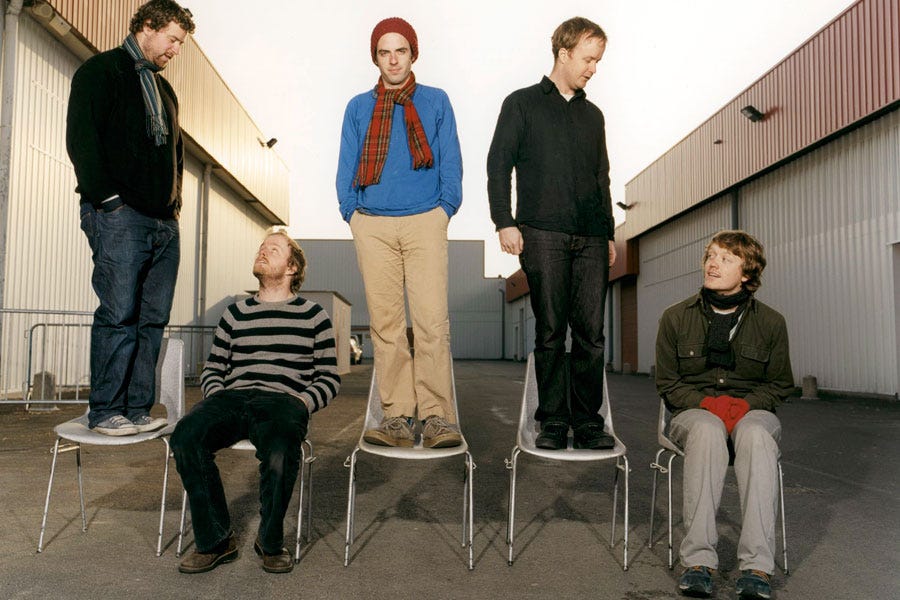Musings on the indienet - looking at Clap Your Hands Say Yeah 20 years later
The Skin of My Yellow Country Teeth - Clap Your Hands Say Yeah
Perhaps no artist was bitten more by the Pitchfork bug than the Brooklynite band Clap Your Hands Say Yeah.
Sure, there were always the Pitchfork darlings — Radiohead was predestined to receive 10s due to founder Ryan Schreiber’s affinity for the band — but their success wasn’t contingent upon the publication’s approval.
The band’s rise to fame, accelerated by hype from a 9.0 Best New Music rating from Pitchfork (one of the highest honors for up-and-coming bands at the time), represented a shift in music discovery, not just for the listeners, but the artists themselves. You could go from playing church basements in Philadelphia to headlining major music festivals within a year.
“The praise took on a meta quality as people celebrated not just the band’s music but the way they rose to fame—i.e.without industry support,” said Sterogum’s Chris DeVille in his new book, Such Great Heights. “It suggested that there was a path forward for artists too arty or obscure to attract the attention of legacy print magazines.”
Say what you want about Pitchfork (and trust me, I have lots to say as well), but it was the closest we got to democratizing taste-making and what’s considered “cool” in music. Pitchfork’s heydays were part of the pre-AI slop, pre-enshittification era of the internet that many of us yearn for and are probably trying to recreate here on Substack.
The rise of Pitchfork and its ilk was coupled with the rise of indie, a genre that’s too often tossed around and misused but somehow makes its way into characterizing anything that isn’t your run-of-the-mill pop. One time, my younger brother called me “indie” for playing a Beatles song in the car.
The simultaneous rise (and fall) of these things wasn’t a coincidence. They were a response to the emergence of a millennium plagued by anxiety, defined by the 9/11 terror attacks, the Internet, Hollywood, and rapid changes in culture as a whole.
DeVille called CYHSY as part of the “blog rock” phenomenon, or left-of-center music that gained popularity thanks to MP3 blogs like Pitchfork. The term was and is sort of derogatory. It implies that their success was mostly due to and could only be found online. In fact, in some sort of forewarning in what would come with the dominance of algorithmic-driven social media models, just as fast as CHYSY rose to fame, they faded into obscurity. Being online, yes, meant more visibility, but that also came with more scrutiny.
CYHSY has had a bit of a resurgence. We’re in the business of nostalgia now, if you didn’t know. Four months ago, the band released a music video featuring the comedian Eric Rahill for their indie-rock power anthem, “The Skin of My Yellow Country Teeth,” which was released nearly 20 years ago. 20!!!!!!!!
I discovered CHYSY one early morning as I walked into Barnard College’s WBAR studio for my weekly show. The bright yellow and pink album cover of the self-titled album laying next to soundboard caught my attention, so I took a picture of it to listen to later. I admit, I very often judge albums based on their covers. I forgot about it for a couple of months, then randomly decided to listen to it on the train.
The song has everything a great indie-rock anthem had back in the day: synths, mellow guitars, painfully earnest lyrics, and a dancey drumbeat. Some may cringe at or fondly embrace the yodeling-style of singing employed by the band’s lead singer, Alec Ounsworth. I personally love it.
In many ways, it makes sense that the song and band gained popularity through blogs. The internet opened worlds for young people, especially those in small towns. That’s what “Skin of My Yellow Country Teeth” is about — yearning for a life outside your hometown in West Virginia in some place like New York City. The song, like the online world that held it, offered an escape for young people in an increasingly anxious time.


